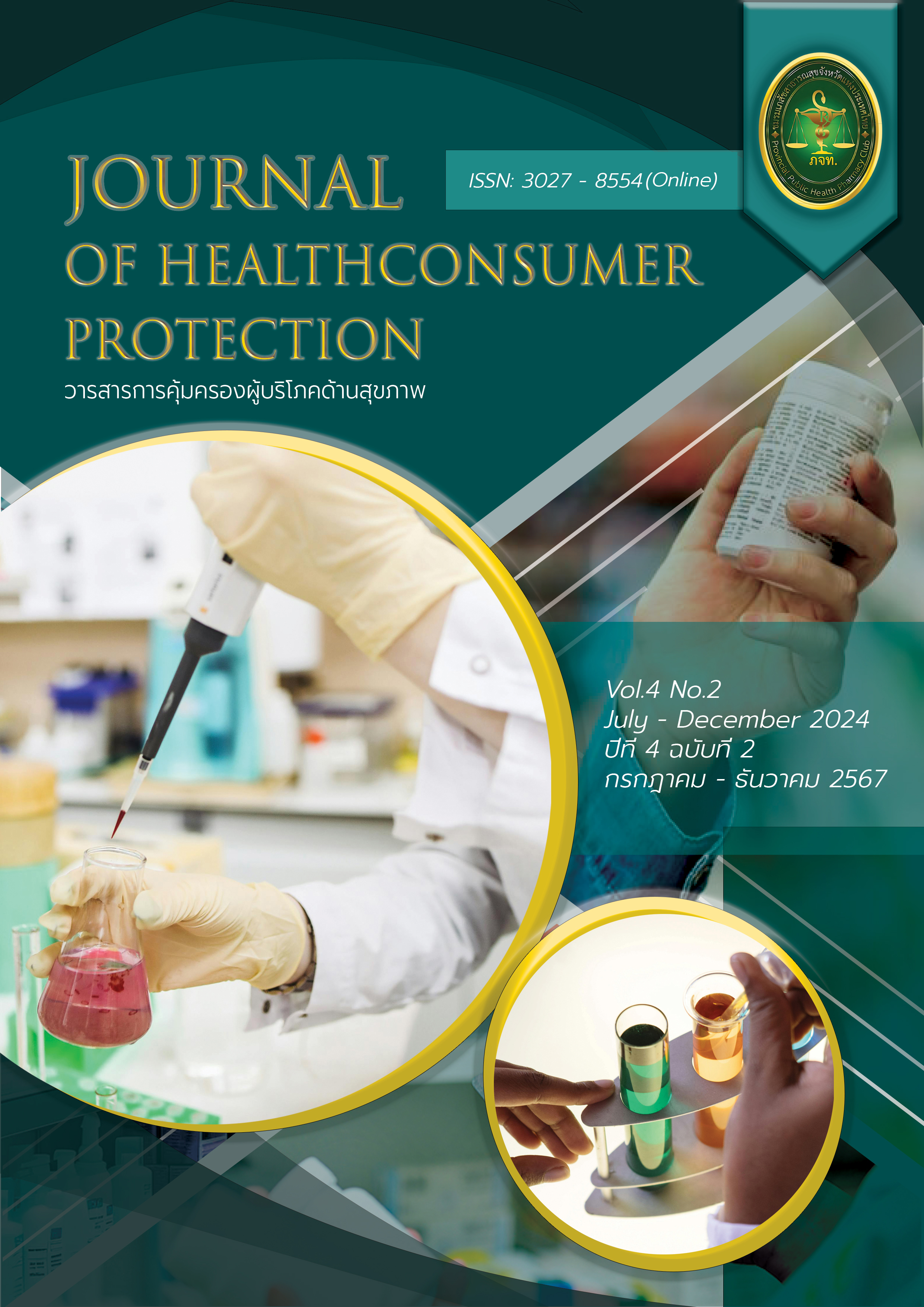ความสัมพันธ์ระหว่างภาวะโภชนาการกับการเสียชีวิตของผู้ป่วยติดเชื้อในกระแสโลหิต
คำสำคัญ:
ภาวะโภชนาการ , ผู้ป่วยติดเชื้อในกระแสโลหิต , การเสียชีวิตบทคัดย่อ
ภาวะติดเชื้อในกระแสโลหิตเป็นสาเหตุหลักในการเสียชีวิตของผู้ป่วยในโรงพยาบาล ภาวะโภชนาการมีผลกระทบต่ออัตราการเสียชีวิตของผู้ป่วยวิกฤต วัตถุประสงค์เพื่อศึกษาความสัมพันธ์ระหว่างภาวะโภชนาการกับการเสียชีวิตของผู้ป่วยติดเชื้อในกระแสโลหิต และหาปัจจัยที่มีความสัมพันธ์กับการเสียชีวิตของผู้ป่วยติดเชื้อในกระแสโลหิต เป็นการศึกษาเชิงพรรณนา ภาคตัดขวางแบบเก็บข้อมูลย้อนหลังในผู้ป่วยที่ได้รับการวินิจฉัยว่ามีการติดเชื้อในกระแสโลหิต และได้รับการคัดกรองภาวะโภชนาการ ระหว่างปี พ.ศ. 2562 ในโรงพยาบาลราชวิถี ผล: ผู้ป่วยจำนวน 808 รายที่ได้รับการวินิจฉัยว่ามีภาวะติดเชื้อในกระแสโลหิต เสียชีวิตรวม 400 ราย (49.5%) พบว่าภาวะโภชนาการไม่มีความสัมพันธ์กับการเสียชีวิตของผู้ป่วยติดเชื้อในกระแสโลหิต ภาวะทุพโภชนาการไม่เป็นปัจจัยเสี่ยงต่อการเสียชีวิตของผู้ป่วยติดเชื้อในกระแสโลหิต ปัจจัยที่มีความสัมพันธ์กับการเสียชีวิตของผู้ป่วยติดเชื้อในกระแสโลหิด ได้แก่ กลุ่มผู้ป่วยที่มีอายุ >60 ปี มีโอกาสเสียชีวิตมากกว่ากลุ่มที่มีอายุ≤40 ปีมากกว่า 2 เท่า ผู้ป่วยที่มีภาวะ septic shock มีโอกาสเสียชีวิตเพิ่มขึ้น 4 เท่า ผู้ป่วยที่ได้รับสารอาหารทางหลอดเลือดดำและผู้ป่วยที่ได้รับสารอาหารทั้งจากทางสายยางและทางหลอดเลือดดำมีโอกาสเสียชีวิตมากกว่าผู้ป่วยที่ไม่ได้รับสารอาหารเกือบ 4 เท่า ผู้ป่วยโรคไตมีโอกาสเสียชีวิตเพิ่มขึ้น 2 เท่า ผู้ป่วยมะเร็งมีโอกาสเสียชีวิตเพิ่มขึ้นเกือบ 2 เท่า กลุ่มผู้ป่วยที่ได้รับยา vancomycin, colistin มีโอกาสเสียชีวิตมากกว่ากลุ่มที่ไม่ได้รับยา 1.67 และ 1.9 เท่า กลุ่มผู้ป่วยที่ได้รับยา quinolone, metronidazole มีโอกาสเสียชีวิตลดลงร้อยละ 40 และ 51 การให้สารอาหารทางหลอดเลือดดำเพิ่มความเสี่ยงในการเสียชีวิต ดังนั้นการให้สารอาหารทางหลอดเลือดดำแก่ผู้ป่วยควรพิจารณาให้กรณีมีความจำเป็น มีข้อบ่งใช้ที่ชัดเจน ในช่วงเวลาที่เหมาะสม
เอกสารอ้างอิง
Rhee C, Dantes R, Epstein L, Murphy DJ, Seymour CW, Iwashyna JT, et al. Incidence and trends of sepsis in US hospitals using clinical vs claims data, 2009-2014. JAMA 2017;318(13):1241-9.
McClelland H, Moxon A. Early identification and treatment of sepsis. Nursing Time 2014;110(4):14-7.
Deutschman CS, Tracey KJ. Sepsis: current dogma and new perspectives. Immunity 2014;40(17):463-75.
Singer M, Deutsschman CS, Seymour CW, Shankar-Hari M, Annane D, Bauer M, et al. The third international consensus definitions for sepsis and septic shock (sepsis-3). JAMA 2016;315(8):801-10.
Rannikko J, Syrjänen J, Seiskari T, Aittoniemi J, Huttunen R. Sepsis-related mortality in 497 cases with blood culture-positive sepsis in an emergency department. Int J Infect Dis 2017;58:52-7.
Rudd KE, Johnson SC, Agesa KM, Shackelford KA, Tsoi D, Kievlan DR, et al. Global, regional, and national sepsis incidence and mortality, 1990-2017: analysis for the Global Burden of Disease Study. Lancet 2020;395(10219):200-11.
World Health Organization. Sepsis. 3 May 2024. [internet] [cited 2024 May 5]. Available from: https://www.who.int/news-room/fact-sheets/detail/sepsis
Rhee C, Jones TM, Hamad Y, Pande A, Varon J, O’Brien C, et al. Prevalence, Underlying Causes, and Preventability of Sepsis-Associated Mortality in US Acute Care Hospitals. JAMA Network Open 2019;2(2):e187571. doi:10.1001/jamanetworkopen.2018.7571
Rhee C, Klompas M. Sepsis trends: increasing incidence and decreasing mortality, or changing denominator. J Thorac Dis 2020;12(Suppl 1):S89-S100.
Dellinger RP, Levy MM, Rhodes A, Annane D, Geriach H, Opal SM, et al. Surviving sepsis campaign: international guidelines for management of severe sepsis and septic shock, 2012. Intensive Care Med 2013;39(2):165-228.
Akksilp S. Sepsis unfinished agenda. Paper presented at World Sepsis Day 2018 Conference; 2018 Sep 6-7; Muangthong Thanee, Bangkok.
Parimanont C, Chaimael P, Woradej S. Nutritional status and factors associated nutritional status in children under 5 years of age: A review of the literature. SCNJ 2018;5(1):329-42.
Mehta NM. Nutritional status and outcomes in pediatric severe sepsis-size matter. Crit Care Med 2018;46(11):1886-7.
Kosalka K, Wachowska E, Slotwinski R. Disorder of nutritional status in sepsis- facts and myths. Prz Gastroenterol 2017;12(2):73-82.
Hung KY, Chen YM, Wang CC, Wang YH, Lin CY, Chang YT. Insufficient nutrition and mortality risk in septic patients admitted to ICU with a focus on immune dysfunction. Nutrients 2019;11(2): 367.
Christopher KB, Rawn JD, McKane CK, Moromizato T, Mogensen KM. The association of malnutrition and sepsis in critical illness: a cohort study. Am J Respir Crit Care Med 2020;201:A3085
Asiimwe SB, Amir A, Vittinghoff E, Muzoora CK. Causal impact of malnutrition on mortality among adults hospitalized for medical illness in sub-Saharan Africa: what is the role of severe sepsis? BMC Nutrition 2015;1:25.
Gao Q, Cheng Y, Li Z, Tang Q, Qiu R, Cai S, et al. Association between nutritional risk screening score and prognosis of patients with sepsis. Infect Drug Resist 2021;14:3817-25. 19. Martin-Loeches I, Guia MC, Vallecoccia MS, Suarez D, Ibarz M, Irazabal M, et al. Risk factors for mortality in elderly and very elderly critically ill patients with sepsis: a prospective, observational, multicenter cohort study. Ann Intensive Care 2019;9(1):26.
Cha JK, Kim HS, Kim EJ, Lee ES, Lee JH, Song IA. Effect of early nutritional support on clinical outcomes of critically ill patients with sepsis and septic shock: a single-center retrospective study. Nutrients 2022;14(11):2318.
Takır HB, Karakurt Z, Saltürk C, Balcı M, Kargın F, Moçin OY, et al. Does Total Parenteral Nutrition Increase the Mortality of Patients with Severe Sepsis in the ICU? Turk Thorac J 2015; 16: 53-8. DOI: 10.5152/ttd.2015.4323
Comerlato PH, Stefani J, Viana LV. Mortality and overall and specific infection complication rates in patients who receive parenteral nutrition: systematic review and meta-analysis with trial sequential analysis. Am J Clin Nutr 2021;114(4): 1535-45. doi: 10.1093/ajcn/nqab218.
Vancomycin. In: Gonzales JP, LoweJF, Rybarczyk A, editors. Adult drug information handbook. 31st ed. Lexi-Drugs. Lexicomp. Wolters Kluwer Health, Inc. Riverwoods, IL; 2022-2023. p. 2324-31.
Colistimethate. In: Gonzales JP, LoweJF, Rybarczyk A, editors. Adult drug information handbook. 31st ed. Lexi-Drugs. Lexicomp. Wolters Kluwer Health, Inc. Riverwoods, IL; 2022-2023. p. 515-17.
ดาวน์โหลด
เผยแพร่แล้ว
ฉบับ
ประเภทบทความ
สัญญาอนุญาต
ประกาศเกี่ยวกับลิขสิทธิ์
บทความที่ได้รับการตีพิมพ์เป็นลิขสิทธิ์ของชมรมเภสัชสาธารณสุขแห่งประเทศไทย
ข้อความที่ปรากฏในบทความแต่ละเรื่องในวารสารวิชาการเล่มนี้เป็นความคิดเห็นส่วนตัวของผู้เขียนแต่ละท่านไม่เกี่ยวข้องกับชมรมเภสัชสาธารณสุขจังหวัดแห่งประเทศไทย และบุคลากรท่านอื่นๆในสำนักงานฯ แต่อย่างใด ความรับผิดชอบองค์ประกอบทั้งหมดของบทความแต่ละเรื่องเป็นของผู้เขียนแต่ละท่าน หากมีความผิดพลาดใดๆ ผู้เขียนแต่ละท่านจะรับผิดชอบบทความของตนเองแต่ผู้เดียว




